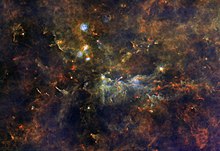Vulpecula OB1
| Vulpecula OB1 | |
|---|---|
 Vulpecula OB1 | |
| Observation data (J2000 epoch) | |
| Constellation | Vulpecula |
| Right ascension | 19h 44.0m [1] |
| Declination | +24° 13′[1] |
| Mean distance | 5.2 kly (1.6 kpc)[2] |
| Radial velocity | 3.1[3] km/s |
| Physical characteristics | |
| Other designations | Vul OB1[1] |
Vulpecula OB1 is an OB association in which a batch of massive stars are being born. It was first identified by W. W. Morgan et al. (1953).[4] The association is located in the Orion Arm about 7,500[5] light-years away from the Sun. Nebulae that are contained in this association include NGC 6820 and NGC 6823,[4] plus Sharpless 2-88.[5]
Vul OB1 contains nearly 100 OB-stars and over 800 young stellar objects. The association is about 100 parsec long and formed homogeneously. The YSOs exist as two populations, one population that represent isolated YSOs and another population that follows the infrared nebulosity. The YSO population is high around Sharpless 2-86, Sh 2-87, Sh 2-88, the compact HII-regions and other star clusters like Cr404. This is suspected to be caused by triggered star-formation. The OB-stars sculpt many of the pillar-like structures in this region.[6]
References
- ^ a b c "Vul OB1". SIMBAD. Centre de données astronomiques de Strasbourg. Retrieved 2020-01-14.
- ^ Melnik, A. M.; Dambis, A. K. (2020). "Distance scale for high-luminosity stars in OB associations and in field with Gaia DR2. Spurious systematic motions". Astrophysics and Space Science. 365 (7): 112. arXiv:2006.14649. Bibcode:2020Ap&SS.365..112M. doi:10.1007/s10509-020-03827-0. S2CID 220128144.
- ^ Mel'Nik, A. M.; Dambis, A. K. (2009). "Kinematics of OB-associations and the new reduction of the Hipparcos data". Monthly Notices of the Royal Astronomical Society. 400 (1): 518. arXiv:0909.0618. Bibcode:2009MNRAS.400..518M. doi:10.1111/j.1365-2966.2009.15484.x.
- ^ a b Thé, P. S.; van Paradijs, J. A. (July 1971). "UBV photoelectric photometry of early type stars in the direction of the associations Vul OB 1 and Vul OB 4". Astronomy and Astrophysics. 13: 274. Bibcode:1971A&A....13..274T.
- ^ a b Billot, N.; et al. (April 2010). "Young Stellar Objects and Triggered Star Formation in The Vulpecula OB Association". The Astrophysical Journal. 712 (2): 797–812. arXiv:1003.0866. Bibcode:2010ApJ...712..797B. doi:10.1088/0004-637X/712/2/797. S2CID 28961682.
- ^ Billot, N.; Noriega-Crespo, A.; Carey, S.; Guieu, S.; Shenoy, S.; Paladini, R.; Latter, W. (2010-04-01). "Young Stellar Objects and Triggered Star Formation in The Vulpecula OB Association". The Astrophysical Journal. 712 (2): 797–812. arXiv:1003.0866. Bibcode:2010ApJ...712..797B. doi:10.1088/0004-637X/712/2/797. ISSN 0004-637X. S2CID 28961682.
